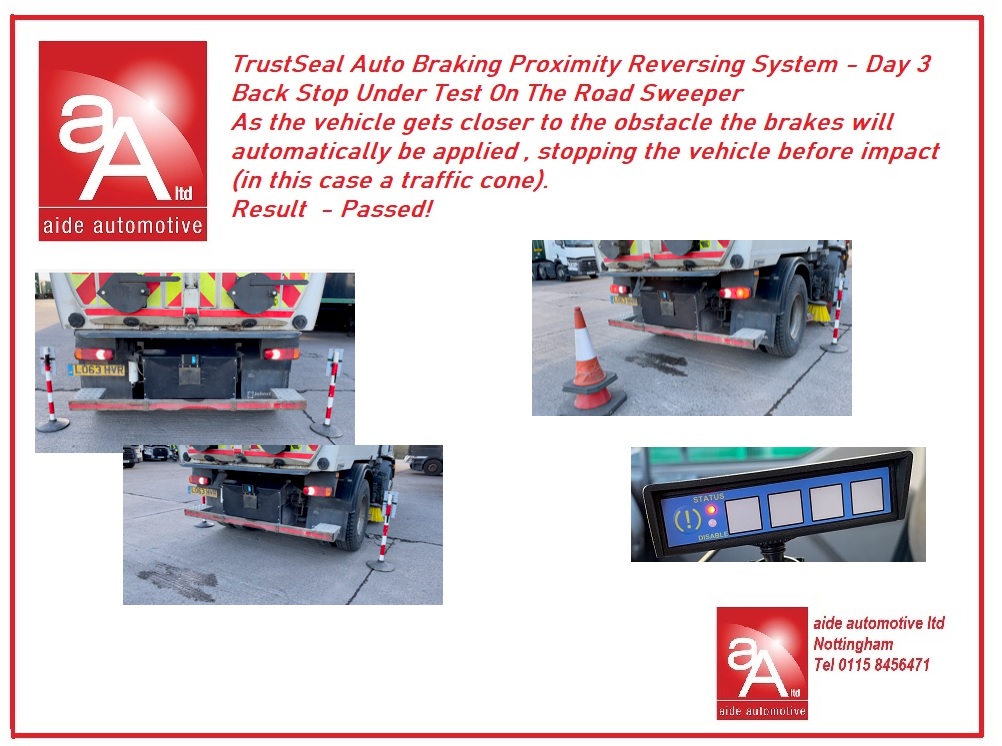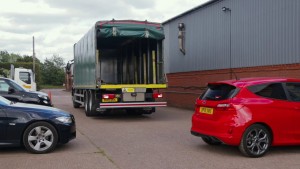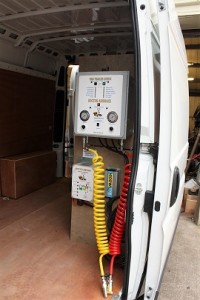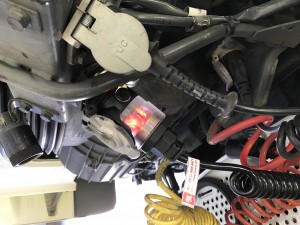Poor service brake performance continues to be a perennial problem for semi-trailers at annual roadworthiness tests. Vehicle and Operator Services Agency (VOSA) statistics confirm that this remains the most common reason for test failure, despite a mushrooming in the number of disc-braked trailers in service. Small wonder then that trailer braking was the main talking point last month in Birmingham at a half-day vehicle-braking seminar organised by IRTE.
A Vehicle Inspectorate plan to require all vehicles and trailers to be laden when presented for test (Transport Engineer August 2001) has not been carried through. This is no bad thing, according to some delegates at the Birmingham seminar. Their view was that trailers stood a better chance of passing when presented unladen. VOSA project engineer Frank Ashurst says the opposite is true. VOSA’s own data shows that by comparison with a loaded trailer, an unladen one is twice as likely to fail on brake performance. Perhaps the explanation for the disagreement lies in the definition of “laden”. In VOSA’s book it means that the load on each trailer axle is at least half the axle’s design weight, though test station staff prefer to see trailers (and trucks) presented for test with every axle carrying at least 65 per cent of design weight. All speakers at the seminar agreed that part-laden with significantly lighter loads is the worst possible condition for a brake test, at least in the UK, where at test pass requires at least 45 per cent of the trailer’s total axle design weight. BPW’s UK technical manager Paul Billson went through the maths, showing that some lightly-laden trailers would need braking efficiency readings of over 100 per cent at each axle to achieve the required 45 per cent of total axle design weight. “This is a physical impossibility,” declared Mr Billson. “The test is really totally unrealistic.”
If the 45 per cent brake-performance threshold were measured against actual axle weight at the time of the test, load-sensing valve effect would be taken into account, he pointed out. Describing this as a “true efficiency” reading, Mr Billson showed how a trailer with a 27-tonne bogie design weight achieved only 35 per cent in the VOSA test but would have achieved 51 per cent had its actual bogie weight of 18.6 tonnes been used instead.
Though dismissing the notion that actual axle weights should be used in brake performance calculations, Mr Ashurst nevertheless sympathised surprisingly strongly with criticism of the design weight fixation. “Why the hell are we testing at design weights?” he wondered, and nobody could offer an answer. Using the UK legal limit (maximum authorised mass or MAM, in the legal jargon) would drop the reference weight from 27 to 24 tonnes for most tri-axles, so some marginal test failures would become passes.
Around 70 per cent of tri-axle semi-trailers at present are presented for test entirely unladen, according to Mr Ashurst. They thus qualify to be assessed on the basis of whether their wheels can be made to lock-up for a given brake force. (Transport Engineer November 1998). “This is a trial we have been running for the last 15 years,” said Mr Ashurst with a grin. It has never formally been written into the legislation. He sees it as a pragmatic solution to the problem but admitted it was one he would rather do without. “Testing on the basis of wheel lock-up is a second best,” he said. BPW’s Paul Billson agrees. “We try to stop trailer wheels locking 364 day a year,” he said. “On the 365th day we want them to lock.” He too urges operators to submit trailers for test laden to as near total axle design weight as possible, “and avoid the part-laden condition like the plague.”
Turning to brake temperatures, Mr Billson urged VOSA to test trailer brakes at normal operating temperature, perhaps by conducting the brake test as soon as a trailer arrived at a test station. Mr Ashurst freely admitted that VOSA’s roller brake testers turn at only three kilometres an hour and thus generate very little heat in friction material. “But it gets my hackles up when operators say their brakes need conditioning before they are tested,” said Mr Ashurst. “Can you guarantee that nobody is going to step out in front of a truck the moment it leaves the depot?”
Mr Ashurst summarised how VOSA has been trying to sharpen up brake testing. This had included a long hard look at techniques used in Germany and elsewhere, including extrapolation of brake performance at low pressures to calculate what it would be at high pressures. There is considerable interest in this among UK fleet operators, not least because it makes high axle loads for brake tests unnecessary. Two
pressure readings are taken while the vehicle or trailer is on the roller brake tester – one from the trailer coupling head (or the truck’s front brake chamber) to show system air pressure, the other from downstream of the load-sensing valve to show how pressure is being modified to suit the load. Accepting that multiple readings at various braking pressures improve the accuracy of extrapolation, Mr Ashurst said that VOSA nevertheless was unpersuaded. He cited problems of inaccessible air tapping points and the time it takes to conduct the test. VOSA had run some extrapolation trials and found poor correlation with conventional testing. “The results were not reliable,” said Mr Ashurst. “The number of false fails would increase, and so would false passes, but not to the same extent, so we didn’t want to go there.”
Shaun Starkey, for one, finds these objections unconvincing. Mr Starkey, fleet manager at BS Eaton, the Staffordshire-based paving products supplier, researched the German extrapolation testing technique years ago (Transport Engineer December 2000) and still believes it beats the UK method. “It seems logical that when Germany builds so many trucks and brake components, it might know how to test them too,” he observes wryly.
“We have admitted defeat when it comes to trying to find a new wonder brake test,” conceded Mr Ashurst. VOSA’s short-term solution is to continue testing brakes in the time-honoured way, but with new-and-improved roller brake testers. An order has just been placed with BM Autoteknik of Denmark. A three-year installation programme at HGV test stations is due to begin this autumn. There is also talk of the load simulators used at VOSA test stations, limited to five tonnes at present, being replaced with simulators capable of imposing 10 tonnes. The option of pulling-down axles has been rejected for several reasons, including practical difficulties in finding suitable lashing points.
It emerged at the Birmingham seminar that VOSA is already beginning to wonder whether in the more distant future annual brake testing of any kind will be necessary. Mr Ashurst floated the idea that a combination of electronic brake actuation (EBS) – fitted to 80 per cent of new trailers supplied to UK operators last year – and on-board diagnostics could tell VOSA all it needs to know about brake performance. The issues, according to Mr Ashurst, revolve around whether EBS can collect the necessary data such as measuring deceleration and relating it to brake pressure; whether VOSA can get at it – “most of it is the other side of the manufacturer’s firewall” and whether the information is secure.
Gathering such data would be no problem for a modern EBS system, according to Brian Robertson, OEM (original equipment manufacturer) trailer and technical manager at Haldex, the brake controls manufacturer. He showed examples of trailers’ EBS braking data, confirming what has long been common knowledge: that about 90 per cent of trailer braking is at pressures below two bar. For one trailer in Mr Robertson’s set, the average pressure of all braking was 1.7 bar. For another (lightly-loaded) trailer the average was a mere 1.3 bar. Operators suffering from trailer brake-test failures need look no further than this EBS data for likely explanations, according to Mr Robertson. Glazed or “sleeping” (under-used) brake pads could soon be spotted. And EBS could be programmed to shape trailer braking at various points along “the braking corridor”, within brake performance boundaries in a graph plotting braking retardation against coupling head pressure, as used for type approval.
But how would a fleet engineer know whether or not a trailer’s EBS program was optimised for any particular operation and gross weight? Roger Thorpe, BPW’s customer services manager, told the seminar that some trailer brake problems arise because trailer manufacturers fail to program EBS correctly, prompting nods of agreement from Haldex’s Brian Robertson and Knorr-Bremse’s Andrew Lumley. Trailer salesmen who failed to identify a trailer’s likely operational pattern and thus missed the chance to customise programming also came in for criticism.
The consensus among speakers was that operators should insist on print-outs of EBS programming when taking delivery of new trailers. Changing an EBS program after delivery requires a VTG 10 (notifiable alteration) form to be completed, delegates were reminded. Rental trailers that can be working on vastly different duties from one day to the next represented the worst case here. One rental fleet engineer said he needed a three-position EBS switch, for light, medium and heavy loads.
Long-standing braking compatibility problems between tractive units and semi-trailers would be solved by the advent of disc brakes and electronic braking systems, it had been promised. Not so, judging by the observations of speakers and delegates at this seminar. Noting that abnormal brake temperatures are a convenient way of spotting compatibility problems, Jeff Lowe, an independent brake engineer, wondered why EBS brakes do not incorporate heat sensors which could transmit temperature data to the truck’s CAN (controller area network) electrical system through the two pins (numbers six and seven) on the seven-pin ISO 7638 ABS connector that are dedicated to the EBS system. Haldex’s Mr Robertson saw no insurmountable technical difficulty but questioned whether operators would accept the on-cost. Replying to another question from Mr Lowe, he agreed that some brake problems arise when new brake chambers are installed because their threshold pressure differs from that of the old ones. Mr Robertson recommends like-for-like swaps when brake chambers are replaced.
Braking compatibility problems have swung through 180 degrees in the past few years, according to BPW’s Mr Billson. Looking back at BPW’s compatibility calculations from 2002, he found that most revealed “aggressive trailer braking”. Not any more. In 2005 it was tractive units that became the aggressors. BPW now sees a growing number of trailers with those “sleeping pads” that fail to wake up when we need them. Mr Billson advises operators to avoid over-use of endurance brakes such as engine brakes or retarders, maybe having periods when they are not used at all, so trailer brakes are given something to do. Another of Mr Billson’s tips to counter under-used trailer brakes when running with new EBS tractors and EBS trailers is to consider using a five-pin ISO 7638 ABS connector rather than the usual seven-pin model. This deactivates the EBS function, but leaves ABS and electronic load-sensing still working. Though the EBS signal is lost, the traditional pneumatic signal is still there for trailer brakes. BPW’s tests have shown that using a five-pin ABS lead shifts more of the braking effort from tractor to trailer. Undeniable benefits of EBS, such as swifter response and roll stability are lost, but it may help ameliorate the sleeping-pad problem.
Knorr-Bremse’s trailer sector account manager Andrew Lumley explained why the latest EBS-equipped tractive units are taking on so much more of an articulated combination’s braking. It seems that it all stems from a poor interpretation of the original (1975) European Union truck-trailer braking legislation, directive 75/524/EEC and its subsequent translation into ECE Regulation 13. At low retardation values (where braking force is less than 0.1 of the vehicle or trailer’s mass) the need for proportionality between the tractor’s braking and coupling head pressure was never spelt out. It is only above this level that the relationship between coupling head pressure and braking effort is closely defined. Describing this as “ineffective legislation” because it left the issue of truck-trailer compatibility undefined in the key area where most check-braking is carried out, Mr Lumley showed how tractor manufacturers set up braking systems to provide virtually no braking effort at low pressure. According to Knorr-Bremse data, even when the coupling head pressure is up to 1.25 bar, a tractor could be providing only 30 per cent of a combination’s total braking effort, leaving the trailer with 70 per cent. By 2.0 bar, the split was more even, at 45/55.
Recent amendments to ECE 13 meant that tractive unit brakes must develop enough braking force at a coupling head pressure between 0.2 and 1.0 bar to prevent a wheel from being turned by hand. This forces tractor manufacturers to start truck braking at much lower pressures. The amendments to ECE regulation 13 became effective on 4 April 2005, but will not apply to all new registrations until April 2009. Introduction into UK Construction and Use regulations is likely to be around 2012. Mr Lumley says that knowing that the amendments were on the way, truck manufacturers have already started implementing them – hence the change towards more aggressive tractor braking detected by BPW.
Andrew Lumley explained how operators can redress the balance and transfer more braking effort back to the trailer when coupling new tractors to non-EBS trailers. The first step was to increase the trailer’s load-sensing valve’s “inshot pressure” – the threshold at which it begins to function – and thus prevent it from reducing trailer braking at low brake pressures. If that was not enough, then adjust the predominance setting on the trailer’s relay emergency valve to apportion more braking to the trailer, advised Mr Lumley. But he warned that adjusting trailers with conventional braking systems to achieve the right compatibility may be tricky. New EBS-braked trailers are far easier to set up. Phew, some good news at last on trailer braking.
aide automotive offer a truck & trailer brake tester, BrakeCheck Truck & Trailer is a portable brake tester in the decelerometer design.








